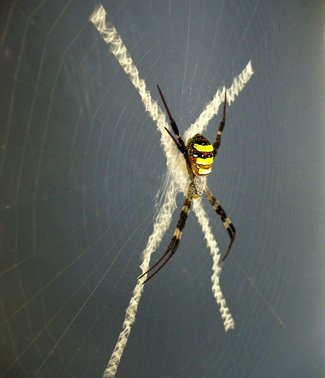Spider web mystery unravelled

DECORATIVE WHITE, SILK crosses are employed by certain orb-weaving spiders as a clever way to protect their webs from damage, a new study from researchers at the University of Melbourne has revealed.
A team lead by Dr André Walter and Professor Mark Elgar discovered that some orb-weaving spiders responded to repeated damage to their webs by building larger silk crosses into them. When damage was minimal these spiders didn’t bother adding more decoration.
Mark points out that repairing damaged webs is very time consuming for a spider so by building a large cross into it, the spider is putting up a ‘sign’ that shows potential threats where the web is. This helps the spider protect their web from excessive damage.
“If people kept walking into a glass door, eventually you would put something up to show that there is a glass door there,” Mark says. “Orb-weaving spiders do the same thing by incorporating silk decorations on their webs.”
Purpose discovered for silk crosses in spider webs
The obvious, cross-shaped signs these orb-weaving spiders produce has been the subject of conjecture among scientists for more than 100 years, as the silk decorations present something of a paradox.
“You would imagine that a spider would build its web to be as inconspicuous as possible for catching prey,” Mark says. “So the conspicuous silk decorations seem like an evolutionary paradox.”
It had been theorised that, due to the UV-light reflecting qualities of the silk crosses, spiders use them to attract prey. While there is some evidence for this, few studies have tested the idea that the signs might ward off potential web-vandals.
“We wanted to explore the idea that spiders decorate their webs in order to reduce the likelihood of damage by non-prey organisms,” Mark says. “We took the less common approach to answering this question.”
In studying animal behaviour, Mark has seen various types of experiments and ways in which scientists solve problems. He believes the approach taken in this study fundamentally differs from other behavioural experiments.
“Instead of recording the amount of damage that is inflicted on webs with different amounts of decoration, we essentially asked the spiders what they would do if their web was continually damaged,” he says.
This approach takes into account the idea that not every species, and indeed not every individual, will behave the same way in a given scenario.
“It seems more interesting to me to present an individual with a circumstance and watch its reaction,” Mark says. “It emphasises the dynamic nature of behaviour.”
RELATED STORIES

